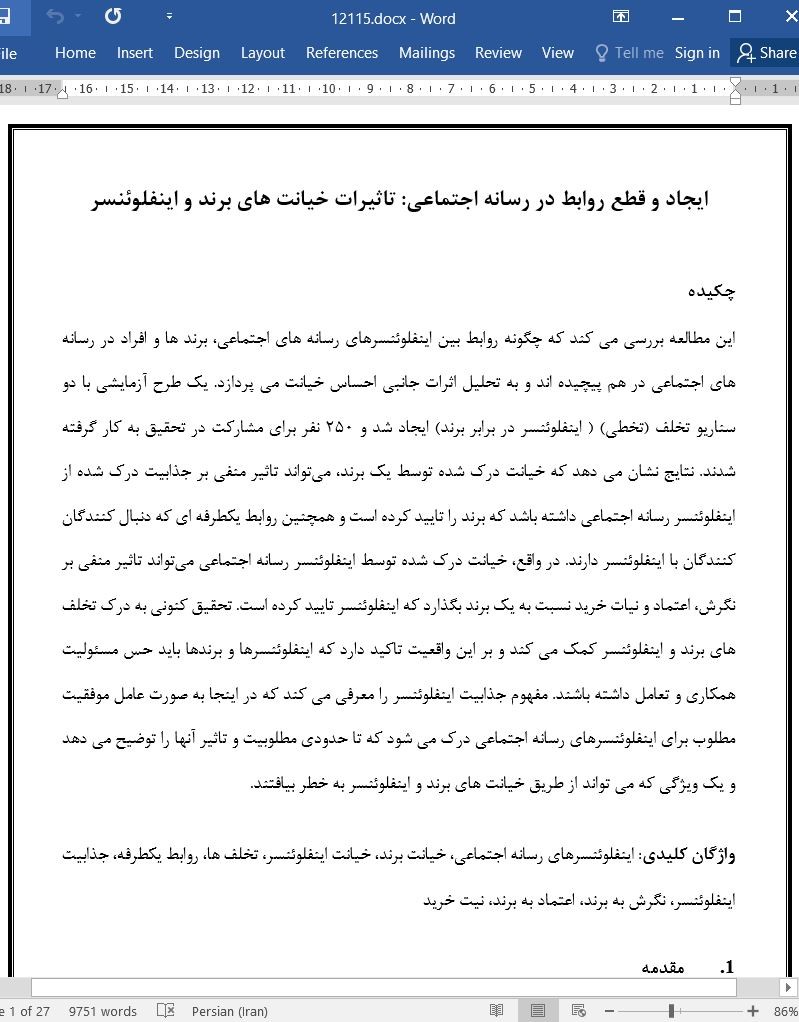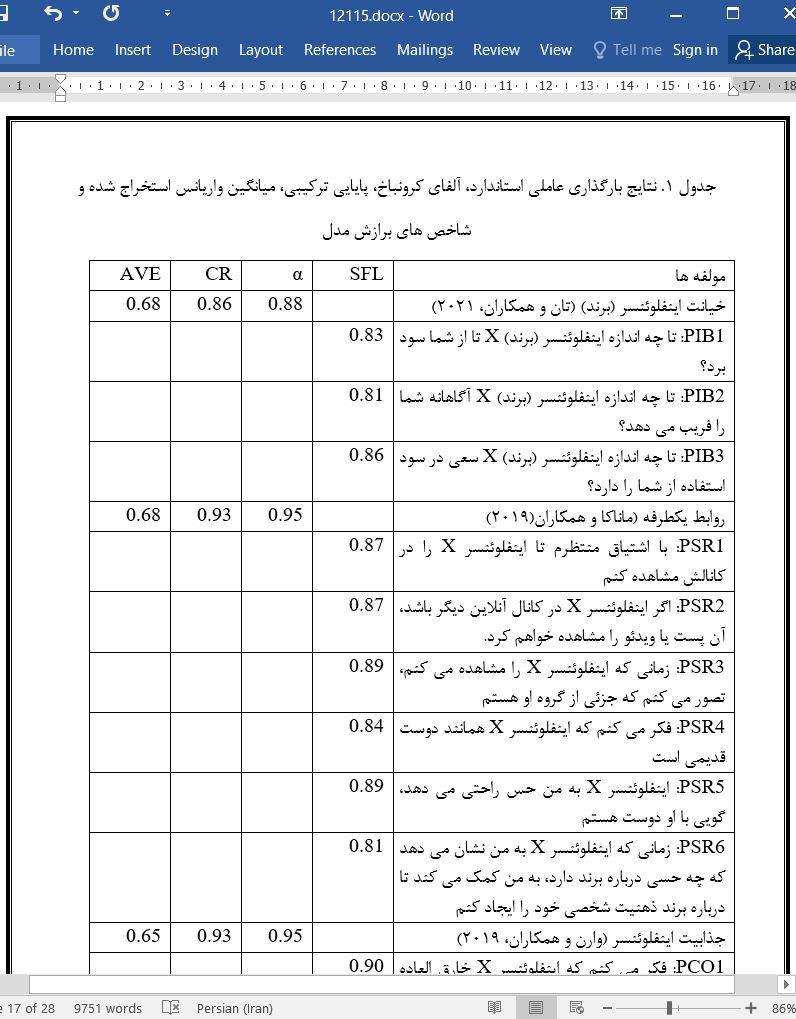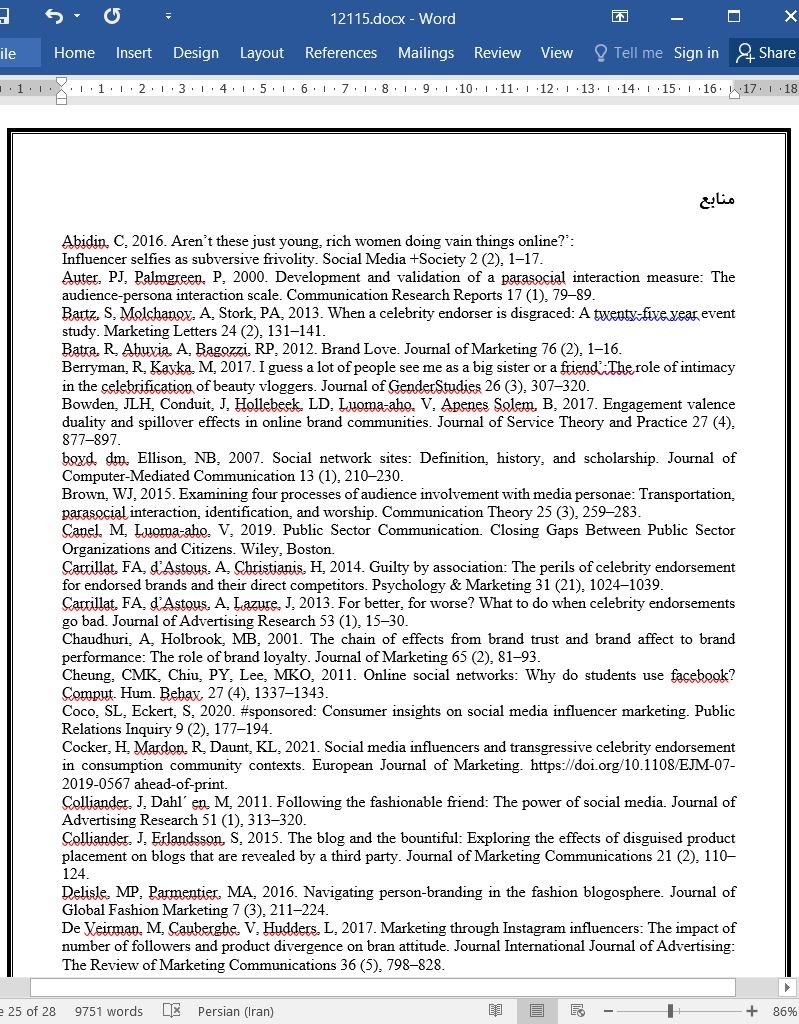
ایجاد و قطع روابط در رسانه اجتماعی: تاثیرات خیانت های برند و اینفلوئنسر
چکیده
این مطالعه بررسی می کند که چگونه روابط بین اینفلوئنسرهای رسانه های اجتماعی، برند ها و افراد در رسانه های اجتماعی در هم پیچیده اند و به تحلیل اثرات جانبی احساس خیانت می پردازد. یک طرح آزمایشی با دو سناریو تخلف (تخطی) ( اینفلوئنسر در برابر برند) ایجاد شد و ۲۵۰ نفر برای مشارکت در تحقیق به کار گرفته شدند. نتایج نشان می دهد که خیانت درک شده توسط یک برند، میتواند تاثیر منفی بر جذابیت درک شده از اینفلوئنسر رسانه اجتماعی داشته باشد که برند را تایید کرده است و همچنین روابط یکطرفه ای که دنبال کنندگان کنندگان با اینفلوئنسر دارند. در واقع، خیانت درک شده توسط اینفلوئنسر رسانه اجتماعی میتواند تاثیر منفی بر نگرش، اعتماد و نیات خرید نسبت به یک برند بگذارد که اینفلوئنسر تایید کرده است. تحقیق کنونی به درک تخلف های برند و اینفلوئنسر کمک می کند و بر این واقعیت تاکید دارد که اینفلوئنسرها و برندها باید حس مسئولیت همکاری و تعامل داشته باشند. مفهوم جذابیت اینفلوئنسر را معرفی می کند که در اینجا به صورت عامل موفقیت مطلوب برای اینفلوئنسرهای رسانه اجتماعی درک می شود که تا حدودی مطلوبیت و تاثیر آنها را توضیح می دهد و یک ویژگی که می تواند از طریق خیانت های برند و اینفلوئنسر به خطر بیافتند.
1. مقدمه
مزایای رسانه اجتماعی بسیار زیاد می باشد، از جمله این واقعیت که پلتفرم های رسانه اجتماعی، فرصت های جدیدی برای تعامل و حفظ روابط با دوستان و عزیزان فراهم کرده است (باید و الیسون، 2007؛ چانگ و همکاران، 2011؛ دیر و همکاران، 2018؛ گانارو و داتون، 2007). علاوه بر این، رسانه اجتماعی ارتباط با انواع جدید دوستان دیجیتال را فراهم کرده است: این نوع جدید از همراهان رابطه میتواند شامل اینفلوئنسرهای رسانه اجتماعی- بلاگرها، یوتیوبرها، سلبرتی های تیک تاک باشد- کسانی که دوستان نزدیک و یا حتی اعضای خانواده فالوورها (بریمان و کاوکا، 2017؛ رینیکانن و همکاران، 2020) و همچنین برندها (فارنیر، 1998)، محسوب میشوند. که می تواند روابط شخصی قوی با برند (تان و همکاران، 2019) یا حتی احساسات عشق (باترا و همکاران، 2012) را در افراد علاقه مند بر انگیزد. این تاثیر میتواند در افراد جوان، شدید باشد، کسانی که غالباً مسحور برندهای معروف می شوند(دیر و همکاران، 2016:427).
8. نتیجه گیری
مطالعه کنونی به بررسی روابط در هم تنیده بین اینفلوئنسرهای رسانه اجتماعی برندها و افراد در رسانه اجتماعی میپردازد. گرچه نشان داده شد که احساسات مثبت از اینفلوئنسرها به برند ها نفوذ می کند(رینیکاینن و همکاران، 2020)، اثرات احساسات منفی نادیده گرفته شده است، مانند احساسات منفی ناشی از نقض اعتماد. مطالعه کنونی به طور خاص به بررسی اثرات خیانت های برند و اینفلوئنسر، به ترتیب بر برند های تایید شده و اینفلوئنسرهای تایید کننده میپردازد.
Abstract
This study considers how the relationships between social media influencers, brands and individuals are intertwined on social media and analyses the spill-over effects of feelings of betrayal. An experimental design with two transgression scenarios (influencer vs. brand) was created, and 250 individuals were recruited to participate in the study. The results show that a perceived betrayal by a brand can negatively affect the perceived coolness of the social media influencer that has endorsed the brand, as well as the parasocial relationships that followers have with the influencer. Accordingly, a perceived betrayal by a social media influencer can negatively affect attitudes, trust and purchase intentions toward a brand that the influencer has endorsed. The current research helps in understanding brand and influencer transgressions and highlights the fact that both influencers and brands should have a sense of collaboration responsibility. It also introduces the concept of influencer coolness, understood here as a desirable success factor for social media influencers, which partly explains their desirability and influence, and a feature that can be endangered through both influencer and brand betrayals.
1. Introduction
The benefits of social media are numerous, including the fact that social media platforms enable new possibilities to interact and maintain relationships with friends and loved ones (e.g., boyd and Ellison, 2007; Cheung et al., 2011; Dhir et al., 2018; Gennaro and Dutton, 2007). In addition, social media also allows connecting with new kinds of ‘digital friends’: These new types of relationship partners can include social media influencers — bloggers, YouTubers, Instagram and TikTok celebrities — who are often considered close friends or even family members by their followers (Berryman and Kavka, 2017; Reinikainen et al., 2020), and also brands (Fournier, 1998), which can evoke strong self-brand connections (Tan et al., 2019) or even feelings of love (Batra et al., 2012) in devoted individuals. This effect may be especially high in young people, who are often ‘fascinated with popular brands’ (Dhir et al., 2016: 427).
8. Conclusion
The current study explores the intertwined relationships between social media influencers, brands and individuals on social media. Although positive emotions have been found to spill over from influencers to brands (Reinikainen et al., 2020), the effects of negative emotions have mostly been overlooked, such as the negative feelings that are caused by trust violations. The present study specifically examined the effects of influencer and brand betrayals on endorsed brands and endorsing influencers, respectively.
چکیده
1. مقدمه
2. مروری بر تحقیقات پیشین
2.1. اینفلوئنسرهای رسانه اجتماعی
2.2. روابط یکطرفه
2.3. جذابیت اینفلوئنسر
2.4. تخطی های برند و اینفلوئنسر
2.5. خیانت برند و اینفلوئنسر
3. چارچوب مفهومی و فرضیه ها
4. روش
5. نتایج
6. بحث کلی
6.1. کاربردهای نظری
6.2. کاربردهای عملی
7. محدودیت ها و تحقیقات آتی
8. نتیجه گیری
منابع
Abstract
1. Introduction
2. Literature review
2.1. Social media influencers
2.2. Parasocial relationships
2.3. Influencer coolness
2.4. Brand and influencer transgressions
2.5. Brand and influencer betrayal
3. Conceptual framework and hypotheses
4. Method
5. Results
6. General Discussion
6.1. Theoretical implications
6.2. Practical implications
7. Limitations and future research
8. Conclusion
Appendix. Supplementary materials
References
- اصل مقاله انگلیسی با فرمت ورد (word) با قابلیت ویرایش
- ترجمه فارسی مقاله با فرمت ورد (word) با قابلیت ویرایش، بدون آرم سایت ای ترجمه
- ترجمه فارسی مقاله با فرمت pdf، بدون آرم سایت ای ترجمه



